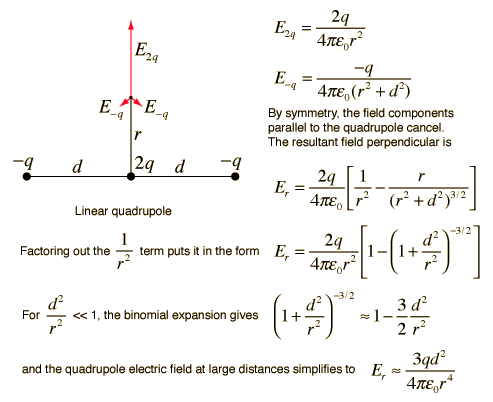http://hyperphysics.phy-astr.gsu.edu/hbase/electric/elequad.html
Electric quadrupole [edit]
 is the electric permittivity.
is the electric permittivity.Electric QuadrupoleA general distribution of electric charge may be characterized by its net charge, by its dipole moment, its quadrupole moment and higher order moments. An elementary quadrupole can be represented as two dipoles oriented antiparallel. Quadrupole and higher order multipoles are not important for the characteriztion of dielectric materials. Dipole fields are much smaller than the fields of isolated charges, but in dielectrics where there are no free charges, the dipole effects are dominant. There is no such circumstance favoring the quadrupole effects, since they must arise from the same number of molecules as the dipole effects. Scott says that the macroscopic quadrupole effects are smaller than dipole effects by about the ratio of atomic dimensions to the distances of experimental observation.
| Index Electric dipole concepts References Cohen Concepts of Nuclear Physics, Ch 1 Scott Sec 3.3 | ||
| Go Back |
Linear Electric QuadrupoleA linear electric quadrupole can be created by superimposing two electric dipoles of opposite orientation so that their positive charges overlap. This case can be treated analytically and gives some insights into the nature of quadrupole fields. The electric field from any collection of charges can be obtained from Coulomb's law by vector addition of the fields from the individual charge elements.
| Index Electric dipole concepts Reference Schwarz Sec 1.4 | ||
| Go Back |


No comments:
Post a Comment